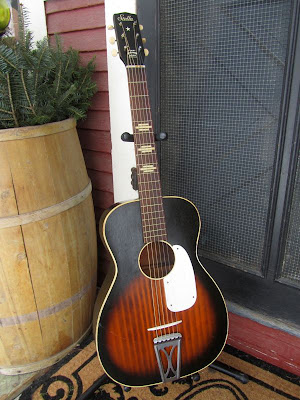c.1965 Harmony-made H929 Stella Guitar

Ah, yes, the everyman's model H929 "Stella" branded parlor-ish sized student guitar. All solid birch, flattop, ladder braced, sturdy, simple -- and when actually setup properly -- not a bad playing or sounding little instrument at all. In fact, I know I've recently seen a number of younger touring musicians using these and similar all over the place.
In 1939 (correct me if I'm wrong) Harmony bought out Oscar Schmidt and brought the OS brand names (Stella, Sovereign, La Scala, etc.) under their own umbrella. In the same year, this model's slight model-number predecessor became available under the Stella name (note that the Oscar Schmidt Stella instruments are entirely different beasts). Since 1945 this model remained relatively unchanged right up to the 1970s and was several generations' first student guitar.
While the factory setup might not have been ideal, many of these guitars (after work) turn into great little take-anywhere workhorses with a bluesy, loud, and mid-rangey tone. These same attributes actually make them great recording guitars as well, since their tonal response is so balanced and flat.

My work on this one included cleaning, a fret dress, setup, and a replacement bridge as well as a few tuner shafts/gears.

The "steel reinforced neck" (steel bar) on this one is perfectly straight, thank the gods. The 24" scale coupled with the 50w-11 string set I have on this fella make a nice 1930s-sort of feel when mixed with the wider, 12-fret style neck.

Fun pseudo-deco painted fret marks and faux-rosewood board. Brass frets.

The white pickguard isn't my first choice of color but works with this instrument's faux-woodgrain top.

The bridge is a random bone mandolin one from my parts box that I popped in to start seeing what height would be right for a new bridge. Well... it sounded just fine so I added some slots for proper guitar spacing and left it like that.



Note the faux-grain on the back, too.

These 3-on-a-plate tuners show evidence of "parts-ing out" in that when I got the guitar, 3 shafts were completely missing and two of the remaining ones had been replaced with mismatched ones. Now it has 6 mismatched shafts, all from about the same era. Fortunately... they work "good enough for government work."

Hah, here's an old "repair" -- bolt through the neck heel and tightened up on the inside. Fair enough...! I expect to see stuff like this on these old student guitars... and more often than not the repair works well (as it does here) though it of course adds some weight.



There a repaired crack on the bass side as you can see here.

...and, as typical, the end pin is broken off inside its socket.

Comments
It would be nice to think she survived all those years. Don't remember the bolt thru the neck though - lol!